| |
 |
Checking into India
For Renuka Chowdhury, the tourism ministry is more than just a job to be held
down until the next cabinet reshuffle. Her focus is on making India the world’s
hottest destination and changing the way the tourism department is run |
|
By Rakesh K Simha
|
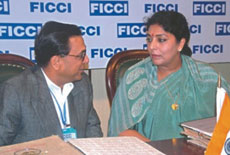 |
|
Indian tourists in London are zapped by the sheer
number of taxis with “Incredible India” painted on them. Cross the channel and
the India sales pitch is again difficult to miss, with the Paris buses sending
across the message to the people of the world’s most fashionable city. Up north
in Amsterdam the trams double up as India’s billboards. The innovative and
aggressive campaign is the brainchild of Minister of State for Tourism, Renuka
Chowdhury, for whom tourism means more than just the Taj Mahal. |
“It’s boom time for tourism in India, which is now the fifth most-favoured
destination in the world, thanks to improved flight capacity, as well as the
“Incredible India” campaign. We are viewed as one of the safest destinations,”
says Chowdhury.
Chowdhury’s ministry is indeed in overdrive. The new
international campaign is in full swing, the Tourism Department has forged
partnerships with its foreign counterparts and foreign journalists are being
invited to visit India. “We have organised road shows and are also finding out
the difficulties faced by tour operators,” she says.
|
|
She has unfolded her vision of how she wants to position India as the tourism
destination of the twenty-first century. The new plan of action has clearly
signalled that tourism will be all about the environment, which India is ideally
placed to offer to the rest of the world. It has tremendous natural beauty, a
wealth of cultural attractions, a rich history, seaside destinations, mountains,
forests and wildlife. Chowdhury is quick to add that the time to act is now to
preserve our environment, not just for our children, but for the tourists and
travellers of tomorrow who will demand nothing less than environmentally
sustainable and socially acceptable tourism. |
|
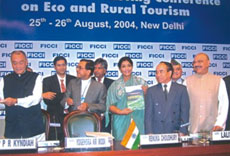 |
The minister believes it is in the interest of a country the size
of India, with such a large population base, to develop industries such as
tourism, which require a lot of manpower. It is a measure of the new importance
of tourism that the Planning Commission has raised the plan allocation of he
ministry from Rs 350 crore to Rs 500 crore.
Night bazaars in Delhi and Hyderabad, eco-tourism at the Lakshadweep and Andaman
and Nicobar islands, an integrated time-bound action plan to promote
infrastructure development and untapped areas like medical and health tourism,
shall be the focus areas.
 |
Tourism is the largest engine of change with a vast potential for employment
opportunities. “We employ more people than the agricultural and industrial
sector. Tourism is not meant for a privileged few, unlike the IT sector,” she
says.
The opportunities thrown up by the sector are numerous. In Khammam district of
Andhra Pradesh, women make paper cups, which are sold at tourist sites all over
the country. To improve wayside amenities, women are being trained to prepare
hygienic food. Souvenir kiosks are popping up across the country. |
|
The tourism ministry has outlined a
training programme for about 26,000 people involved with tourism. Taxi
drivers, tourist guides, petrol station personnel on highways, and even
immigration officers are trained for skills such as courtesy, etiquette,
effective communication and hygienic service. On completion of training,
they will sport a logo, (Athithi devo bhava, or Guest is God), which would
help foreigners identify genuine tourist personnel. The training programme,
currently on in Delhi, will soon spread to other centres.
The true potential of domestic tourism is yet to be
recognised, says Renuka. “We do not take into account the traffic during
marriage seasons, festivals, and visits to friends and relatives during the
slack season. I would like to pamper domestic tourism because these are our
people. In two years, India will complete 60 years of Independence. For `Shashti
Poorti India’ we are drawing up special plans for domestic tourism,” she
says.
|
The tourism ministry wants to upgrade all facilities, including toilets,
hygienically prepared food and clean wayside amenities. “Let us approach
this creatively. There are many people with good homes who can generate
income by offering bed and breakfast, similar to what they have in Ireland,
Scotland and other countries. It also reduces the pressure on hotels, which
are difficult to run during the off-season. Star hotels are a necessity
today, because India is not only a destination for tourists but also for
patients and their families who stay for long durations. Apart from that,
India is a `mind-destination’, as we have people coming for meetings,
exhibitions and conferences throughout the year.” |
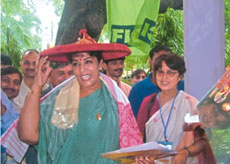 |
|
Reduced domestic airfare would spur
domestic tourism, she feels. She is canvassing for lowering the price of
aircraft fuel, which is taxed by State Governments, to help bring down
airfare. About 49 lakh Indians travel outside the country because it’s
cheaper to fly to countries like Singapore, Malaysia and Bangkok,
compared with domestic air travel.
For the first time the ministry has addressed medical tourism. Chowdhury
points out that Indian doctors offer 36 per cent of the medical services
in the US and UK. The credibility of medical education in India, English
language skills and the sunny climate beckon patients from abroad. The
contribution by private medical institutions and hospitals offering
state-of-the-art facilities have helped benchmark medical services in
the country.
Nearly 60,000 patients have visited India for hip and
knee replacement surgery, bypass surgery, cosmetic and other surgery
during the last four years.
A taskforce comprising the tourism ministry, health ministry and the CII
has been constituted to promote medical tourism. This is expected to
give a fillip to both Indian indigenous medical systems and allopathy.
Hospitals are being accredited to enable categorisation.
While India is known for its monuments and historical sites, their
deplorable state is a matter for concern. The tourism ministry works in
tandem with the Culture Ministry and the Archaeological Survey of India,
which are responsible for the maintenance of historical monuments.
Renuka moots public-private partnerships.
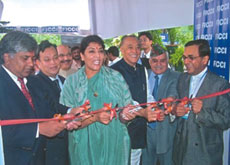 |
The concept of ‘tourism police’—a boon to tourists,
particularly women—is receiving a major thrust. The idea is to sensitise
the police to problems faced by tourists, guide them to their
destination, assist them when there is loss of passport or money, and
ensure safety at tourist spots. Tourism police is also expected to deter
harassment of women tourists, especially foreigners.
“Sometimes people from other countries come with different dress codes,
not anticipating the orthodoxy prevalent here, which can be quite
challenging and frightening to some tourists,” she says. |
|
Another niche that the minister is looking at is Buddhist pilgrimage.
Chowdhury is determined to take the work forward from where Jagmohan had
left it. Like her predecessor, Chowdhury is bullish about promoting the
Buddhist circuit. Not only has her ministry identified 22 Buddhist sites
across the country, she has either sanctioned or is in the process of
sanctioning several projects for infrastructure development in most of
these sites.
The minister also plans to encourage high-end tourism that has the
potential to contribute substantially to the economy.
Observers believe Chowdhury can
swing it. After all, they say, she is a post-graduate in industrial
psychology. And she is an old hand at politics. She has held a
number of significant positions like member, Rajya Sabha (two
terms); chief whip, Telugu Desam Parliamentary Party, Rajya Sabha
(1986-98); Union Minister of State, Health and Family Welfare
(1997-98); elected to the 13th Lok Sabha (1999); Union Minister of
State, Health and Family Welfare (1997-98); Member, Committee on
Finance (1999-2000) and Member, Committee on the Empowerment of
Women (2000-2001).
|
Apart from being politically active and duly branded
a “firebrand” for her outspoken nature, she has a number of
literary, artistic and scientific accomplishments to her credit. She
has written many articles and short stories for children. She has
enthusiastically associated herself with various social and cultural
organisations and has been contributing zealously in the field of
women and child development and welfare.
Chowdhury is known to take tough and controversial decisions. Like
the transfer of tourism secretary Uma Pillai in February over the
purchase of a large consignment of Johnnie Walker whisky by the
Indian Tourism Development Corporation (ITDC) from Diageo.
Apparently, the former secretary became the minister’s target when
she suggested that the tourism ministry should keep out of ITDC’s
commercial dealings. Johnnie Walker brands disappeared from ITDC’s
duty-free shops as a result of the controversy. The controversy,
however, soon died out. |
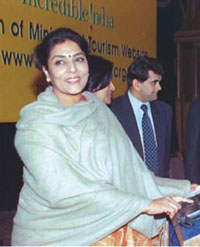 |
Also, she came under a barrage
of protests when she suggested that night food courts be opened
at the site of ancient monuments. That proposal was hastily
withdrawn.
However, the minister has stuck to her plans to change the face
of tourism in India. Towards that end, Chowdhury has put the
bureaucracy to work. It remains to be seen how deep the changes
have sunk in. |
|
|
|
|
|
|
|